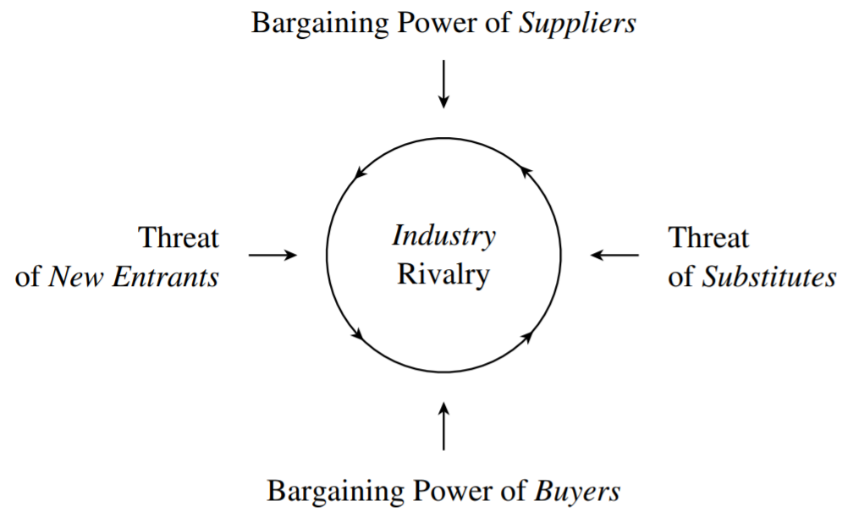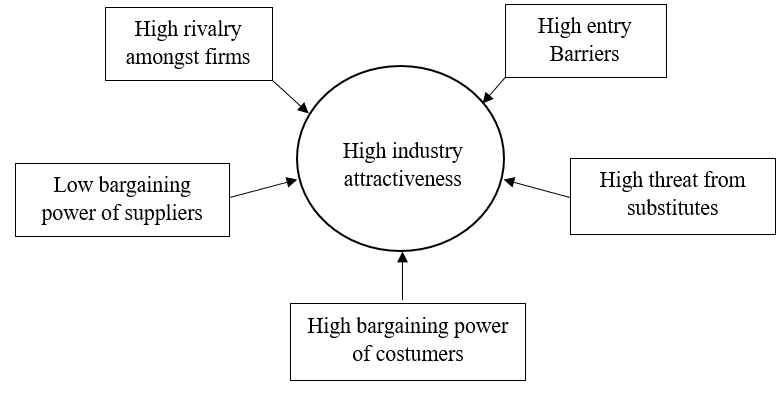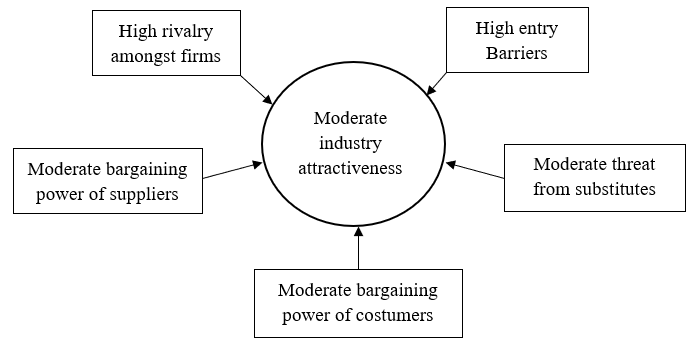BBMM506 Strategic management
2018
Group Assignment
CASE STUDY OF AUSTRALIAN SUPERMARKETS
NAME:
Contents
2.1. General environment analysis 2
2.2. Porter’s five force analysis 2
- Bargaining power of suppliers 3
- Threat of substitute products or services 3
- Bargaining power of customers 4
- Threat of new entrants 4
- Intensity of competitive rivalry 4
2.3. Competitive environment for Coles 5
3.1. High effective supply chain 6
The supermarkets and retail stores industry in Australia is a moderately capital-intensive and fiercely competitive industry. The total revenue for this industry is $ 103 billion in 2018 with the annual growth of 2.1% from 2014 to 2018. Furthermore, this industry meets the need of 348,766 employment and include 1966 different businesses(Afgc.org.au, 2018). The major participants in this industry mainly include Woolworths, Coles, Costco, IGA, FoodWorks, ALDI and Foodland (Ethical.org.au, 2018). The market becomes more competitive currently. Therefore, to analyze the external market environment and enhance internal strength is important for the participant to become more competitive. This report will examine an Australia retailer Coles and its position in the supermarket industry. Moreover, by analyzing its significant resources and capabilities,internal strength will be demonstrated as well. Furthermore, based on the external and internal analysis, recommendations for the future development of Coles will be given at the end of this report.
The external analysis will include the general environment which introduces the socio-cultural factors, which will bring influence to Coles. Furthermore, Porter’s five force analysis will be applied to assess how competitive the supermarket environment is and then the current and future market environment for Coles will be introduced.
Coles, one of Australia’s major supermarket chains, has more than 800 locations across currently and has grown into an iconic Australian retailer. The revenue earned by Coles in 2018 is $39,388 million (Wesfarmers.com.au, 2018). The main reason for Coles to attract customers is that Cole aims to create a strong point of difference in the supermarket place. Therefore, it invests in improving the quality of the fresh and organic food offer, tailoring stores to meet the need of local communities, and providing a suite of convenient shopping environment for customers (Knight, 2018). Those factors can help Coles exploit a different and strong way when facing the competition between local and foreign supermarkets.
In this section, the supermarket industry will be examined by analyzing the five forces, which are supplier power, buyer power, potential entrants, substitute products and rivalry among competitors.

Figure1 Porter’s five force model
According to Grundy (2006), the bargaining power of suppliers is also known as the inputs of the market, which can include materials, components, labour, and services. If the number of suppliers in the market declined, consumers have no alternative choice but buy the product form the only or few suppliers. In this circumstance, the bargaining power of suppliers is high.
The bargaining power of suppliers for Coles is low before but become moderate in the past five years. Based on the statement of Knight(2018), Woolworths and Coles have taken 80% market share in the supermarket industry in Australia. Therefore, a large number of customers will choose Coles or Woolworths. Based on Frank (2018), most Australia farms and producers have to sell their products to these two supermarkets. In other words, Coles has many choices and can switch suppliers easily. Therefore, the power of suppliers used to be very low. However, comparing to the past, with the expanding of German supermarket ALDI over the past five years, this industry’s operation pattern has been altered. The low-price and private-label products become famous. Therefore,Woolworths and Coles have to cut prices and expand their private-label product ranges in response (Ibisworld.com.au, 2018). Furthermore, the farm and producers have more choices to supply their products, which means the bargaining power of Woolworths and Coles decreases currently. Hence, this power becomes a more moderate level now.
Based on Grundy (2006), similar products can change the propensity of customers, in other words, customers will switch their choices to alternatives. If the market is full filled with similar products, then the threat of substitute products or services is high.
This threat posed to Coles is high. As it is introduced by Ethical.org.au (2018), there are many competitors in the Australia market such as the convenience stores, farmers’ markets and specialist grocery (chemist warehouse). For convenience stores such as seven-eleven, it has irreplaceable advantages including location and time-saving that Coles may not have. For farmers’ markets, their products may be fresher, and the price can be lower than the supermarket, which Coles may lose competitive advantages on fresh vegetables and fruits. For specialist grocery such as chemist warehouse which always has a discount, Coles may not have an advantage if compete with them directly. As those substitutes have entered into the market for several years, Coles has set solutions to resolve that. Therefore, the threat becomes moderated now.
Similar to the bargaining power of suppliers, the bargaining power of customers can also be named as the outputs of the market. If there are many alternatives in the market, then the buyer power is high. In contrast, if the firm act independently, the power of customers is low. (Argyres & McGahan, 2002).
The bargaining power of the customers in Coles is moderate currently. As it has been introduced before, with the entry of Aldi and Costco, the choices for consumers are increased. Therefore, buyer power increased. Comparing to the past market which mainly occupied by Coles or Woolworths and the buyer power is low, the Bargaining power of customers become to a more moderate level now.
Based on Dulcic et al. (2012), high returns industry with profitable markets will attract new entrants. It will cause the decile of profitability for all firms in this industry eventually.
The threat of new entrants in Australia supermarket industry is very low. According to Nariu(2008), numbers of factors can influence the entry of new entrants such as government policy, buyer propensity to substitute and relative price performance of substitute. Firstly, new entrants are limited by government policy. For example, the location of the supermarket is regulated by the planning sector as it is important to the town and community activity centers. Secondly, local supermarkets perform better on meet the need of local buyer propensity. Finally, Aldi and Costco which have the ability to supply low-priced products have entered into this market and performed well. However, it is hard for a supermarket with small supply chains to provide a better price performance of substitutes.
For the most industries, the intensity of competitive rivalry is the main factor of the competitiveness of the industry, which may be affected by the level of advertising expense, firm competitive strategy and competitive strategy (Argyres & McGahan, 2002).
A high degree of rivalry exists in Australia supermarket market. Based on the statement of Nariu (2008), there are two main reasons which are the lack of perceivable differentiation on products and the small numbers of participants in the market. Therefore, the main competition is the price.
As the two figures shows below, Costco and Aldi bring huge influence to Australia supermarket industry. From the Porters five-forces analysis, the attractiveness for this industry have decreased since the bargaining power of suppliers and buyers become moderate and the threat of substitute decreased.

Figure 2 Australia supermarket industry attractiveness for Coles several years ago

Figure 3 Australia supermarket industry attractiveness for Coles current years
Based on the annual report made by Wesfarmers.com.au (2018), by cooperating with the supplier Laurent, Coles focus on improving the proportion of sales on fresh food categories and provide higher quality and gain large range of fresh food market share. Furthermore , Coles Online achieved close to 30 percent sales and transaction growth, which meet the need of customers to offer anytime and anywhere. At the same time, approximately 4,500 items on ‘Everyday Low Pricing’. High effective supply chain and low price can help Coles to become more competitive.
There are four main factors which contribute Coles group reputation which are sustainability, Australian sourcing, community support and high product quality (Frank, 2018). Based on Wesfarmers.com.au (2018), Coles aims to offer customers great products and to reduce environmental impacts. It is committed to providing its customers with safe, high-quality products, which are mainly from Australian farmers, producers, and growers. Furthermore, Coles has contributed to serving communities across Australia for 104-year. All factors help Coles to enhance its reputation in this industry.
According to Wesfarmers.com.au (2018), Coles aims to win together, which means provide better store retention for permanent team members which include nearly 3,600 Indigenous team members and increase job satisfaction. Furthermore, reasonable leadership framework which can help to build the right culture and capabilities for team members is introduced in Coles management team. With effective management, it not only contributes to the internal development of Coles but also bring a positive influence to their supply chain and the relationships between suppliers and customers. Therefore, it can help to improve the competitive advantages eventually.
For the recommendations, two aspects are included, which are short-term and long-term recommendations. For the short-term, Coles can invest more on the advertisements on their highly effective supply chain, which may include the concept of fresh and healthy food. The advertising can help to enhance the brand reputation. Although the supply chain is a cost-intensive investment, the products price will not be influenced. Fresh products with attractive price could be one of strength for Coles to compete with other participants. For long-term recommendations, to arrange more convenience stores the Coles Express can help to occupy more market share of this industry and provide a more convenient shopping experience for customers.
In conclusion, from the external aspect, the entry of Aldi and Costco brought changes to the supermarket industry in Australia, the attractiveness of this industry changed from high to moderate. This change benefits Coles as the price competition in the future will not be fierce. Moreover, from the internal aspect, high effective supply, brand reputation, and effective management can help Coles to enhance the market share and become more competitive.
Afgc.org.au (2018). Industry Performance » Australian Food & Grocery Council . Retrieved from https://www.afgc.org.au/key-projects/industry-performance/
Argyres, N., &McGahan, A. (2002). An interview with Michael Porter. Academy Of Management Perspectives , 16(2), 43-52. doi: 10.5465/ame.2002.7173495
Dobbs, ME (2012). Porter’s Five Forces in Practice: Templates for Firm and Case Analysis. Competition Forum, 10(1), 22–33
Duke, D. (2018). Porter’s Five Forces and the Coffee Industry . Management Teaching Review, 3(3), 241–251.
Dulčić, Ž., Gnjidić, V., &Alfirević, N. (2012). From Five Competitive Forces to Five Collaborative Forces: Revised View on Industry Structure-firm Interrelationship . Procedia – Social AndBehavioral Sciences, 58, 1077-1084. doi: 10.1016/j.sbspro.2012.09.1088
Ethical.org.au (2018). Supermarkets in Australia | Shop Ethical . Retrieved from https://www.ethical.org.au/3.4.2/get-informed/issues/supermarkets-in-australia/
Frank, C. (2018). Coles invites grocery suppliers to try the $150 challenge . Retrieved from https://www.news.com.au/finance/business/retail/test-yourself-against-the-reality-coles- invites-grocery-suppliers-to-try-the-150-challenge/news-story/7960688d83b707d4bd35caf442da9cd5
Grundy, T. (2006). Rethinking and reinventing Michael Porter’s five forces model . Strategic Change, 15(5), 213-229. doi: 10.1002/jsc.764
Ibisworld.com.au (2018). Supermarkets and Grocery Stores – Australia Industry Report | IBISWorld. Retrieved from https://www.ibisworld.com.au/industry-trends/market-research-reports/retail-trade/food- retailing/supermarkets-grocery-stores.html
Knight, E. (2018). Woolworths v Coles – the report card is in. Retrieved from https://www.smh.com.au/business/woolworths-report-card–plenty-of-room-for-improvement -20150625-ghxo9q.html
Nariu, T. (2008). The Role of Reputation in the Market for Consumer Goods: Entry Barriers and the Wheel of Retailing . Japanese Economy, 35(2), 39-53. doi: 10.2753/jes1097-203×350203
Wesfarmers.com.au (2018). Wesfarmers annual report 2018. Retrieved from https://www.wesfarmers.com.au/docs/default-source/reports/wes18-044-2018-annual-report.pdf?sfvrsn= 6
